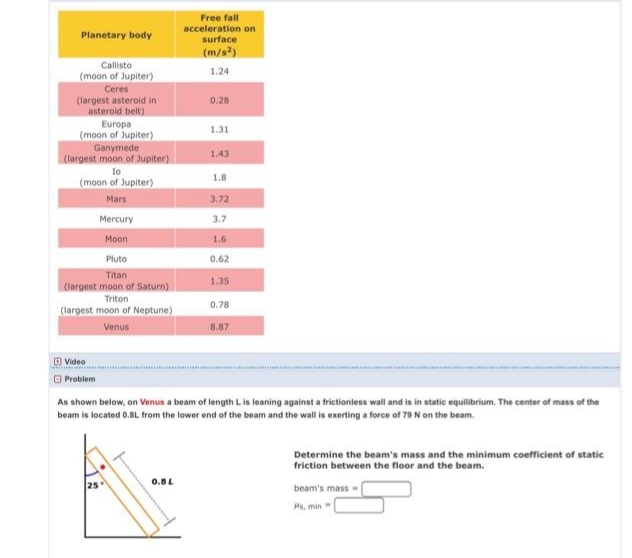As shown below, on Venus a beam of length L is leaning against a frictionless wall and is in static equilibrium. The center of mass of the beam is located 0.BL from the lower end of the beam and the wall is exerting a force of 79 N on the beam.
As shown below, on Venus a beam of length L is leaning against a frictionless wall and is in static equilibrium. The center of mass of the beam is located 0.BL from the lower end of the beam and the wall is exerting a force of 79 N on the beam.
Astronomy
1st Edition
ISBN:9781938168284
Author:Andrew Fraknoi; David Morrison; Sidney C. Wolff
Publisher:Andrew Fraknoi; David Morrison; Sidney C. Wolff
Chapter14: Cosmic Samples And The Origin Of The Solar System
Section: Chapter Questions
Problem 19E: Present theory suggests that giant planets cannot form without condensation of water ice, which...
Related questions
Concept explainers
Rotational Equilibrium And Rotational Dynamics
In physics, the state of balance between the forces and the dynamics of motion is called the equilibrium state. The balance between various forces acting on a system in a rotational motion is called rotational equilibrium or rotational dynamics.
Equilibrium of Forces
The tension created on one body during push or pull is known as force.
Question

Transcribed Image Text:Free fall
acceleration on
surface
(m/s?)
Planetary body
Callisto
(moon of Jupiter)
1.24
Ceres
(largest asteroid in
asteroid belt)
0.28
Europa
(moon of Jupiter)
1.31
Ganymede
(largest moon of Jupiter)
1.43
Io
1.8
(moon of Jupiter)
Mars
3.72
Mercury
3.7
Moon
1.6
Pluto
0.62
Titan
1.35
(largest moon oft Saturn)
Triton
0.78
(largest moon of Neptune)
Venus
8.87
O Video
O Problem
As shown below, on Venus a beam of length L is leaning against a frictionless wall and is in static equilibrium. The center of mass of the
beam is located 0.8L from the lower end of the beam and the wall is exerting a force of 79 N on the beam.
Determine the beam's mass and the minimum coefficient of static
friction between the floor and the beam.
0.8L
beam's mass
Hs, min
Expert Solution
This question has been solved!
Explore an expertly crafted, step-by-step solution for a thorough understanding of key concepts.
This is a popular solution!
Trending now
This is a popular solution!
Step by step
Solved in 3 steps with 3 images

Knowledge Booster
Learn more about
Need a deep-dive on the concept behind this application? Look no further. Learn more about this topic, physics and related others by exploring similar questions and additional content below.Recommended textbooks for you

Astronomy
Physics
ISBN:
9781938168284
Author:
Andrew Fraknoi; David Morrison; Sidney C. Wolff
Publisher:
OpenStax

Foundations of Astronomy (MindTap Course List)
Physics
ISBN:
9781337399920
Author:
Michael A. Seeds, Dana Backman
Publisher:
Cengage Learning


Astronomy
Physics
ISBN:
9781938168284
Author:
Andrew Fraknoi; David Morrison; Sidney C. Wolff
Publisher:
OpenStax

Foundations of Astronomy (MindTap Course List)
Physics
ISBN:
9781337399920
Author:
Michael A. Seeds, Dana Backman
Publisher:
Cengage Learning


Physics for Scientists and Engineers: Foundations…
Physics
ISBN:
9781133939146
Author:
Katz, Debora M.
Publisher:
Cengage Learning


Horizons: Exploring the Universe (MindTap Course …
Physics
ISBN:
9781305960961
Author:
Michael A. Seeds, Dana Backman
Publisher:
Cengage Learning